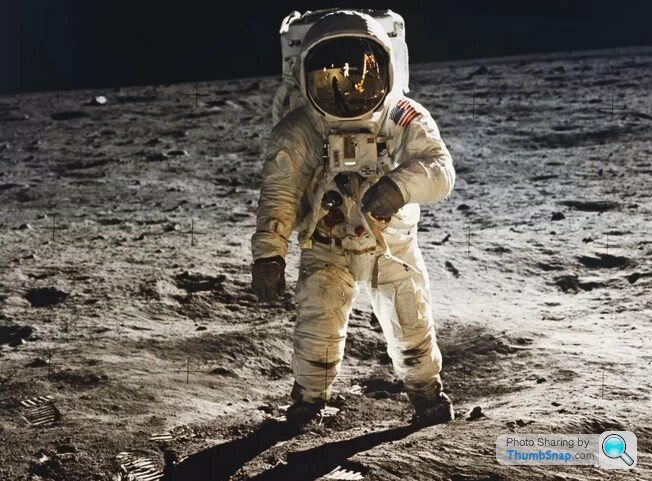Saturn V anecdote
Discussion
Eric Mc said:
djdest said:
I watched an excellent documentary on BBC iplayer this morning called The last man on the moon, all about Eugene Cernan
Saw it last week. It was pretty good - but the book is much better Definitely one of the best astronaut books I’ve read. It was great to read about something and then watch the footage after YouTube.
I’ve seen a lot of the clips before, but watching them again with more insight and an idea of what the crew were doing and feeing made them even more interesting.
Highly recommended!
If you want to see detailed video footage of individual Apollo missions using original audio communications , I'd highly recommend lunarmodul5's You Tube channel. He's put a massive amount of work into his various You Tube projects.
Here's some examples of what he has done. I use the tapes as background noise when I'm working sometimes -
https://www.youtube.com/channel/UC9joNm8jec_JdGF7U...
Here's some examples of what he has done. I use the tapes as background noise when I'm working sometimes -
https://www.youtube.com/channel/UC9joNm8jec_JdGF7U...
From Stephen Coester:
"A tale about the first LH2 load into the new Pad B storage tank at the beginning of the Apollo program before Apollo 10.
We were experts from loading hundreds of liquid hydrogen tankers on Pad A so I wasn't concerned about this hazardous but routine operation. I was the engineer in charge of this initial fill. We cleared the area of nonessential personnel, blocked off the pad perimeter road, stationed the fire trucks and did all of our preparations.
The first wave of five tankers were backed up to the LH2 fill manifold, the manual valves opened and the tankers pressurized to initiate flow. I relaxed once flow began knowing we had dozens more to offload to chill down the warm new 850000 gallon tank and get it filled at 7-10 thousand gallons per tanker.
Suddenly I heard a crack and looked up from my procedure which was resting on the LH2 fill manifold. As I stared, the pipe started bending against its supports and all of a sudden the bellows in the manifold started breaking and liquid air began venting out of the vacuum jacketed outer pipe. I immediately yelled for the tanker operators to vent their tanks and for my mechanics to close the fill manifold valves and open the vent valves.
Whew! We were now safe, but what the hell had happened?
It turned out that for unknown reasons the designers didn't make the fill manifold the same as on Pad A. Normally the inner pipe would be made of Invar, a metal that wouldn't shrink when subjected to the -423 degree LH2 temperature. Instead they built it using 316 stainless steel which shrinks two inches for every forty feet of length. And theyused the same bellows in the outer vacuum jacket pipe as on Pad A. So when the pipe got hit with that super cold temperature it contracted and the bellows couldn't handle all that shrinkage. First the pipe bent like a snake and then the bellows cracked. Quite impressive and a bit scarey.
Fortunately the inner pipe didn't break and no hydrogen escaped. The system now couldn't support filling the storage tank so it was delayed for a month or so while the fill manifold was torn apart and beefier bellows installed. Finally we got the tank filled with LH2 in time to support Apollo 10....and as far as I know that same repaired fill manifold supported all subsequent Skylab, Soyuz and Shuttle missions on LC-39B."

Postscript - "When they took the fill manifold apart they found a partially eaten sandwich in the annulus between the pipes. No wonder we sometimes had trouble maintaining the extreme vacuum in there."
"A tale about the first LH2 load into the new Pad B storage tank at the beginning of the Apollo program before Apollo 10.
We were experts from loading hundreds of liquid hydrogen tankers on Pad A so I wasn't concerned about this hazardous but routine operation. I was the engineer in charge of this initial fill. We cleared the area of nonessential personnel, blocked off the pad perimeter road, stationed the fire trucks and did all of our preparations.
The first wave of five tankers were backed up to the LH2 fill manifold, the manual valves opened and the tankers pressurized to initiate flow. I relaxed once flow began knowing we had dozens more to offload to chill down the warm new 850000 gallon tank and get it filled at 7-10 thousand gallons per tanker.
Suddenly I heard a crack and looked up from my procedure which was resting on the LH2 fill manifold. As I stared, the pipe started bending against its supports and all of a sudden the bellows in the manifold started breaking and liquid air began venting out of the vacuum jacketed outer pipe. I immediately yelled for the tanker operators to vent their tanks and for my mechanics to close the fill manifold valves and open the vent valves.
Whew! We were now safe, but what the hell had happened?
It turned out that for unknown reasons the designers didn't make the fill manifold the same as on Pad A. Normally the inner pipe would be made of Invar, a metal that wouldn't shrink when subjected to the -423 degree LH2 temperature. Instead they built it using 316 stainless steel which shrinks two inches for every forty feet of length. And theyused the same bellows in the outer vacuum jacket pipe as on Pad A. So when the pipe got hit with that super cold temperature it contracted and the bellows couldn't handle all that shrinkage. First the pipe bent like a snake and then the bellows cracked. Quite impressive and a bit scarey.
Fortunately the inner pipe didn't break and no hydrogen escaped. The system now couldn't support filling the storage tank so it was delayed for a month or so while the fill manifold was torn apart and beefier bellows installed. Finally we got the tank filled with LH2 in time to support Apollo 10....and as far as I know that same repaired fill manifold supported all subsequent Skylab, Soyuz and Shuttle missions on LC-39B."

Postscript - "When they took the fill manifold apart they found a partially eaten sandwich in the annulus between the pipes. No wonder we sometimes had trouble maintaining the extreme vacuum in there."
Edited by MartG on Saturday 2nd June 17:16
Stephen has uploaded more stories here http://www.usna63.org/classmates/roster/cur-bio/31...
More from Stephen Coester
Saturn V LC-39 LH2 Adventures in vacuum pumping.
When I came to the LH2 engineering group in 1966, it was virtually brand new and they hadn't had to do much maintenance on the vacuum jacketed 10" LH2 transfer lines. Each forty foot long pipe section had a televac vacuum gauge and the mechanics had a fairly large box to read the vacuum level in each line.
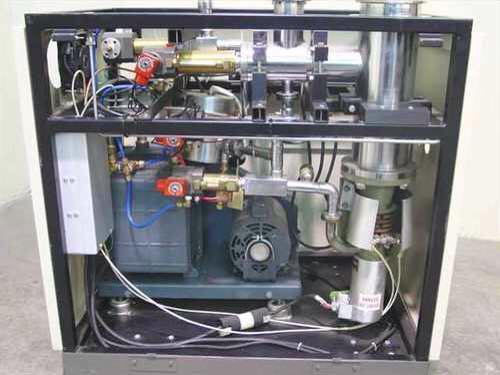
There were about forty line sections across the pad and twenty on each LUT. It was soon discovered that the lines weren't as maintenance free as they were supposed to be. In the event that the lines needed evacuating we had been supplied with a couple of Varian diffusion pumps. These were large similar to the first photo and had very small casters on the base and a trailer tow bar. They weren't very stable when towing across railroad tracks or across the field and were known to tip over. The pumps had an eight inch flange on top and we had these huge 8" vacuum flex hose to connect to the vacuum port on the transfer line which was only two inches. And worse they operated off of 480 volts and there wasn't any 480 running across the field so that had to be installed. Now 480 volts is really dangerous and for some reason the facility electrical guys could never get all the outlets phased the same. And phasing was critical because wrong phasing could make the vacuum pump run backwards and spew pump oil out instead of sucking in. Well first I determined that those huge flex hoses weren't going to work so I reduced the pump flange down from 8" to 1" and substituted tygon tubing for the big unwieldy hoses. The mechanics made up some pigtails to correct the phasing problem and were supposed to momentarily start the pump, verify correct rotation and if wrong use the right pigtail. One mechanic didn't check and while pumping one of the lines beneath the LH 2 disconnect tower filled the annulus with pump oil. This destroys the vacuum and the ability to maintain a vacuum. We pumped for days with no positive effect and then I came up with the brilliant idea to heat the line to boil out the oil. I searched around and found that North American the S-II contractor had some flexible heat blankets and were willing to lend them to me. We applied the blankets but could not get the temperature I wanted so I had the mechanics wrap the blankets with fiberglass insulation. This worked great and we got the temperature up and were making headway when I noticed smoke. We tore off the insulation and the blankets were burned to a crisp. The North American guys weren't real pleased with me. I called my logistics people and they said not to worry they would buy some new ones.
I mentioned the danger of 480 volts. We were pumping a line on the LUT which is all metal. We were investigating a leak in the line and had a mass spectrometer working with us. The Bendix mass spec operator was leaning on his machine and touched our vacuum pump. Next thing we knew he was flung about ten feet and was unconscious. He was seriously injured and I'm not sure if he ever returned to work. I never fully understood the chain of events but our electrical people made serious grounding mods to our machines.
Over time we determined that these big diffusion pumps weren't needed for the level of vacuum required in our transfer lines. The diffusion pumps could evacuate to about a ten thousandth of a micron while we were satisfied with 100 microns. I convinced our design group to use a simple mechanical pump like in the second photo. It was light and ran off of 110 volts which solved a lot of our problems.
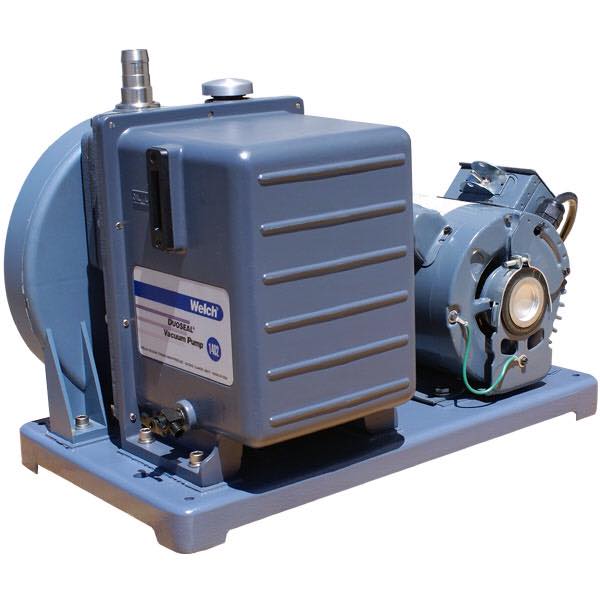
For those who aren't familiar a micron, is an SI derived unit of length equaling 1×10−6 metre (SI standard prefix "micro-" = 10−6); that is, one millionth of a metre (or one thousandth of a millimetre, 0.001 mm, or about 0.000039 inch). When used in vacuum it refers to the pressure exerted by that height of mercury. One atmosphere is 760000 microns.
Over the program we made many modifications to the transfer lines themselves replacing the vacuum gauges, completely changing the pumping port and other improvements.
Saturn V LC-39 LH2 Adventures in vacuum pumping.
When I came to the LH2 engineering group in 1966, it was virtually brand new and they hadn't had to do much maintenance on the vacuum jacketed 10" LH2 transfer lines. Each forty foot long pipe section had a televac vacuum gauge and the mechanics had a fairly large box to read the vacuum level in each line.

There were about forty line sections across the pad and twenty on each LUT. It was soon discovered that the lines weren't as maintenance free as they were supposed to be. In the event that the lines needed evacuating we had been supplied with a couple of Varian diffusion pumps. These were large similar to the first photo and had very small casters on the base and a trailer tow bar. They weren't very stable when towing across railroad tracks or across the field and were known to tip over. The pumps had an eight inch flange on top and we had these huge 8" vacuum flex hose to connect to the vacuum port on the transfer line which was only two inches. And worse they operated off of 480 volts and there wasn't any 480 running across the field so that had to be installed. Now 480 volts is really dangerous and for some reason the facility electrical guys could never get all the outlets phased the same. And phasing was critical because wrong phasing could make the vacuum pump run backwards and spew pump oil out instead of sucking in. Well first I determined that those huge flex hoses weren't going to work so I reduced the pump flange down from 8" to 1" and substituted tygon tubing for the big unwieldy hoses. The mechanics made up some pigtails to correct the phasing problem and were supposed to momentarily start the pump, verify correct rotation and if wrong use the right pigtail. One mechanic didn't check and while pumping one of the lines beneath the LH 2 disconnect tower filled the annulus with pump oil. This destroys the vacuum and the ability to maintain a vacuum. We pumped for days with no positive effect and then I came up with the brilliant idea to heat the line to boil out the oil. I searched around and found that North American the S-II contractor had some flexible heat blankets and were willing to lend them to me. We applied the blankets but could not get the temperature I wanted so I had the mechanics wrap the blankets with fiberglass insulation. This worked great and we got the temperature up and were making headway when I noticed smoke. We tore off the insulation and the blankets were burned to a crisp. The North American guys weren't real pleased with me. I called my logistics people and they said not to worry they would buy some new ones.
I mentioned the danger of 480 volts. We were pumping a line on the LUT which is all metal. We were investigating a leak in the line and had a mass spectrometer working with us. The Bendix mass spec operator was leaning on his machine and touched our vacuum pump. Next thing we knew he was flung about ten feet and was unconscious. He was seriously injured and I'm not sure if he ever returned to work. I never fully understood the chain of events but our electrical people made serious grounding mods to our machines.
Over time we determined that these big diffusion pumps weren't needed for the level of vacuum required in our transfer lines. The diffusion pumps could evacuate to about a ten thousandth of a micron while we were satisfied with 100 microns. I convinced our design group to use a simple mechanical pump like in the second photo. It was light and ran off of 110 volts which solved a lot of our problems.

For those who aren't familiar a micron, is an SI derived unit of length equaling 1×10−6 metre (SI standard prefix "micro-" = 10−6); that is, one millionth of a metre (or one thousandth of a millimetre, 0.001 mm, or about 0.000039 inch). When used in vacuum it refers to the pressure exerted by that height of mercury. One atmosphere is 760000 microns.
Over the program we made many modifications to the transfer lines themselves replacing the vacuum gauges, completely changing the pumping port and other improvements.
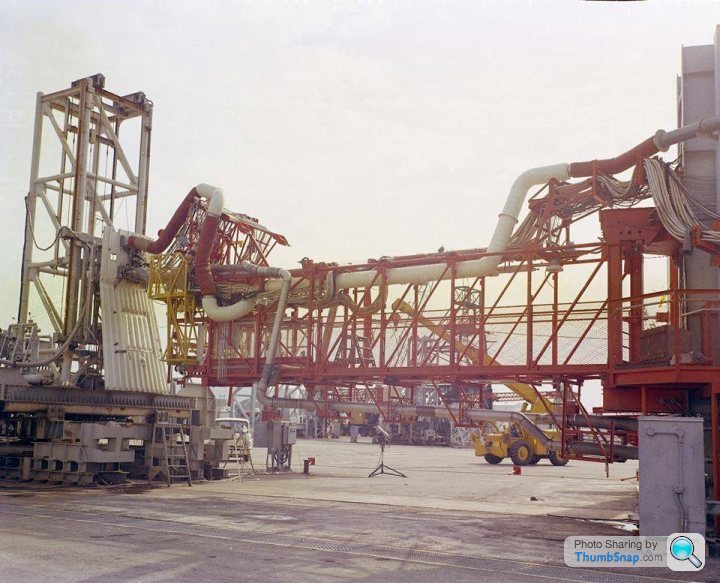
The Random Motion/Lift-Off Simulator (aka the "Arm Farm") at Marshall Space Flight Center.
July 28, 1967
The Marshall Space Flight Center (MSFC) played a crucial role in the development of the huge Saturn rockets that delivered humans to the moon in the 1960s. Many unique facilities existed at MSFC for the development and testing of the Saturn rockets. Affectionately nicknamed “The Arm Farm”, the Random Motion/ Lift-Off Simulator was one of those unique facilities. This facility was developed to test the swingarm mechanisms that were used to hold the rocket in position until lift-off. The Arm Farm provided the capability of testing the detachment and reconnection of various arms under brutally realistic conditions. The 18-acre facility consisted of more than a half dozen arm test positions and one position for testing access arms used by the Apollo astronauts. Each test position had two elements: a vehicle simulator for duplicating motions during countdown and launch; and a section duplicating the launch tower. The vehicle simulator duplicated the portion of the vehicle skin that contained the umbilical connections and personnel access hatches. Driven by a hydraulic servo system, the vehicle simulator produced relative motion between the vehicle and tower. On the Arm Farm, extreme environmental conditions (such as a launch scrub during an approaching Florida thunderstorm) could be simulated. The dramatic scenes that the Marshall engineers and technicians created at the Arm Farm permitted the gathering of crucial technical and engineering data to ensure a successful real time launch from the Kennedy Space Center.
MartG said:

The Random Motion/Lift-Off Simulator (aka the "Arm Farm") at Marshall Space Flight Center.
July 28, 1967
The Marshall Space Flight Center (MSFC) played a crucial role in the development of the huge Saturn rockets that delivered humans to the moon in the 1960s. Many unique facilities existed at MSFC for the development and testing of the Saturn rockets. Affectionately nicknamed “The Arm Farm”, the Random Motion/ Lift-Off Simulator was one of those unique facilities. This facility was developed to test the swingarm mechanisms that were used to hold the rocket in position until lift-off. The Arm Farm provided the capability of testing the detachment and reconnection of various arms under brutally realistic conditions. The 18-acre facility consisted of more than a half dozen arm test positions and one position for testing access arms used by the Apollo astronauts. Each test position had two elements: a vehicle simulator for duplicating motions during countdown and launch; and a section duplicating the launch tower. The vehicle simulator duplicated the portion of the vehicle skin that contained the umbilical connections and personnel access hatches. Driven by a hydraulic servo system, the vehicle simulator produced relative motion between the vehicle and tower. On the Arm Farm, extreme environmental conditions (such as a launch scrub during an approaching Florida thunderstorm) could be simulated. The dramatic scenes that the Marshall engineers and technicians created at the Arm Farm permitted the gathering of crucial technical and engineering data to ensure a successful real time launch from the Kennedy Space Center.
The moon program and the Manhattan program show, that when the US really unify on a project, it gets done right

We covered the technical failures in the challenger disaster at work and that shows what can happen when they don't.
We came close to having a major fire/catastrophe during the Apollo program. The 850,000 gallon liquid hydrogen tank is continuously boiling off the -423F liquid and it must be vented to prevent over pressurizing the tank. The primary vent path was out to the burn pond on Apollo or the flare stack on Space Shuttle. During non operational periods the tank was continuously vented out a pipe at the top of the tank. There were two 12 inch manual valves to direct the flow one way or the other and one was always open and the other closed depending on whether we were in a loading operation or in a standby condition. The valves were chained and locked to prevent unauthorized changing.
We detected internal leakage through one of the valves and it was decided it needed to be changed out. This was a problem because draining the tank was a big deal and there wasn't enough helium in the free world to purge and inert the tank.
I was charged with figuring out how to accomplish the valve changeout without draining and purging the tank. I came up with a plastic containment with gloves like in a hazardous biological lab that would fit around the valve and could be purged with helium. Also I had made a guillotine like device that could be slid in between the valve and the upstream piping to seal off the tank while the valve was being removed. The valve was huge and required a crane to lift it? Sounded good in theory.
Then I arranged for anti-static mats to be placed under the valve and large fans were set up to blow any escaped hydrogen away. We opened the vent valve going to the burn pond to get the tank pressure as close to zero as possible.
We got all this set up and the mechanics started removing the valve flange bolts inside my super containment box. As soon as the seal was broken the box immediately filled with explosive hydrogen gas and visibility was reduced to zero. They ripped off the box and managed to get my guillotine seal in place but not before we had a huge cloud of vapor surrounding us all. The defective valve was then lifted by the crane and removed. Then they had no choice but to lift the replacement valve into place, remove the temporary seal and bolt the new valve in place, once again in a billowing cloud of hydrogen vapor.
Somehow nothing ignited and the valve installation was successfully accomplished. Another of my not so shining moments as I was directing the operation and being sure we were all going up in flames.
Steven Coester
We detected internal leakage through one of the valves and it was decided it needed to be changed out. This was a problem because draining the tank was a big deal and there wasn't enough helium in the free world to purge and inert the tank.
I was charged with figuring out how to accomplish the valve changeout without draining and purging the tank. I came up with a plastic containment with gloves like in a hazardous biological lab that would fit around the valve and could be purged with helium. Also I had made a guillotine like device that could be slid in between the valve and the upstream piping to seal off the tank while the valve was being removed. The valve was huge and required a crane to lift it? Sounded good in theory.
Then I arranged for anti-static mats to be placed under the valve and large fans were set up to blow any escaped hydrogen away. We opened the vent valve going to the burn pond to get the tank pressure as close to zero as possible.
We got all this set up and the mechanics started removing the valve flange bolts inside my super containment box. As soon as the seal was broken the box immediately filled with explosive hydrogen gas and visibility was reduced to zero. They ripped off the box and managed to get my guillotine seal in place but not before we had a huge cloud of vapor surrounding us all. The defective valve was then lifted by the crane and removed. Then they had no choice but to lift the replacement valve into place, remove the temporary seal and bolt the new valve in place, once again in a billowing cloud of hydrogen vapor.
Somehow nothing ignited and the valve installation was successfully accomplished. Another of my not so shining moments as I was directing the operation and being sure we were all going up in flames.
Steven Coester
Wow, squeaky bum moment or what. I think running away, very fast might have been an option is our have considered.
A a senior authorised person, I have done isolations for work on our hydrogen systems at work and it really focuses the mind. We use CO2 to purge our pipe work and it works really well as we have ~1000Te on site
We also used to have a hydrogen/oxygen production plant on site using lye and electrolysis. We took the plant out to replace some purity instruments and managed to burn away 20M of stainless steel impulse pipe work in an oxygen fire.
A a senior authorised person, I have done isolations for work on our hydrogen systems at work and it really focuses the mind. We use CO2 to purge our pipe work and it works really well as we have ~1000Te on site
We also used to have a hydrogen/oxygen production plant on site using lye and electrolysis. We took the plant out to replace some purity instruments and managed to burn away 20M of stainless steel impulse pipe work in an oxygen fire.
As NASA’s facilities and launch complexes were being constructed for the Saturn V, at Kennedy Space Center, one of the problems was how to get the Saturn V from the VAB to the launch pad. Studies were done transporting the Saturn V via barge down the many water canals or via rail. Barry Schlenk, a Bucyrus-Erie Company representative, contacted NASA’s Deputy Chief of the Future Launch Systems Study Office to discuss overhead cranes for use with the Titan missile. Schlenk happened to mention a steam shovel crawler as a possible alternative for moving the Saturn V. In 1962 Launch Operations officials visited Paradise, Kentucky to witness a Bucyrus-Erie 2,700 metric-ton crawler-shovel in action. The coal mining crawler-shovel was found to have a platform that could be leveled and stabilized on uneven terrain carrying immense weight.
Water transport was later found to be unreliable as transport via barge proved unstable not only in water, but with wind as a factor as well. Rail was deemed the worst for transport as curved rails would pose a problem carrying the immense rocket weight even with reinforcements and the rails would require a complex switching system. Even a combination of the two was ineffective. The crawler method was found to be the best as a crawler could be designed and built for the Saturn V, modeled after the coal mining crawler-shovel. The crawler method received a boost when the U.S. Army Corps of Engineers also conducted their own study and found the crawler was the best way to transport the rocket to the launch pad.
After the Apollo Program ended, the Crawler-Transporters had continued use in transporting the Space Shuttles to the launch pad and are currently being modified for use with the Orion Program.
( pic - A Bucyrus-Erie steam shovel crawler)
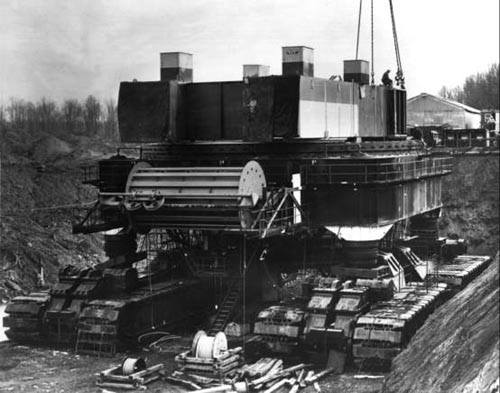
Water transport was later found to be unreliable as transport via barge proved unstable not only in water, but with wind as a factor as well. Rail was deemed the worst for transport as curved rails would pose a problem carrying the immense rocket weight even with reinforcements and the rails would require a complex switching system. Even a combination of the two was ineffective. The crawler method was found to be the best as a crawler could be designed and built for the Saturn V, modeled after the coal mining crawler-shovel. The crawler method received a boost when the U.S. Army Corps of Engineers also conducted their own study and found the crawler was the best way to transport the rocket to the launch pad.
After the Apollo Program ended, the Crawler-Transporters had continued use in transporting the Space Shuttles to the launch pad and are currently being modified for use with the Orion Program.
( pic - A Bucyrus-Erie steam shovel crawler)

I always think that this film had a massive influence on how the Saturn V was transported from the assembly building to the pad -
https://www.youtube.com/watch?v=_7XgP7rws5c
Don't forget, it was made in 1929.
https://www.youtube.com/watch?v=_7XgP7rws5c
Don't forget, it was made in 1929.
Skii said:
On the subject of books I recently ordered a second hand copy of "Falling to Earth" by Al Worden for the princely sum of £5
I was quite chuffed to discover it was a signed copy

I had similar fortune with Wlat Cunningham's "All American Boys". £2.00 from Amazon, signed.I was quite chuffed to discover it was a signed copy


I also have both of their signatures in my "Apollo - Through the Eyes of the Astronauts" book. Each accompanied by the event ticket receipts where they were signed. Not the most valuable Apollo signatures of course, but nice to have.
Gassing Station | Science! | Top of Page | What's New | My Stuff




